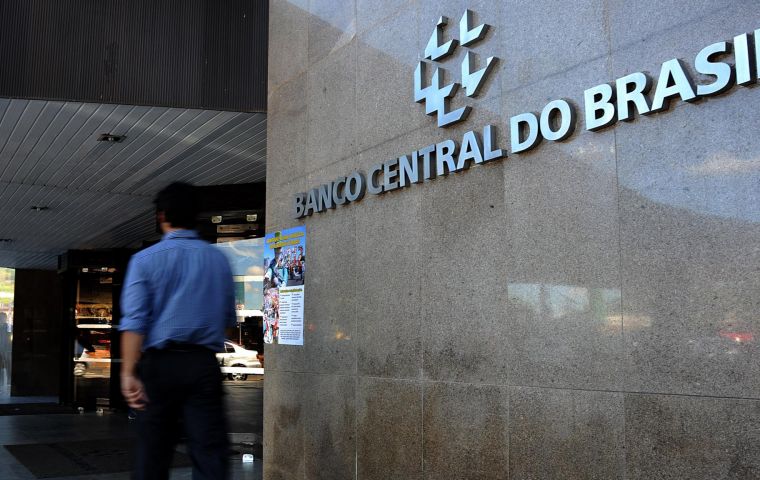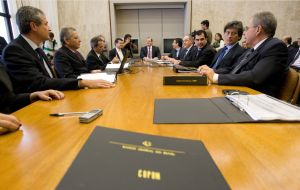MercoPress. South Atlantic News Agency
Brazil central bank leaves benchmark rate at 6.50%; forecasts of 5.50% by December
 Announcing its decision hours after the Fed opened the door for U.S. interest rate cuts, Copom voted unanimously to keep the Selic rate unchanged
Announcing its decision hours after the Fed opened the door for U.S. interest rate cuts, Copom voted unanimously to keep the Selic rate unchanged  The nine-strong committee noted Brazil’s economic recovery had stalled and inflation risks had evolved “favorably”
The nine-strong committee noted Brazil’s economic recovery had stalled and inflation risks had evolved “favorably” Brazil’s central bank held its benchmark interest rate at a record-low 6.50% on Wednesday, as expected, holding back from signalling looser policy because of doubts on economic reforms. The scenario outlined by policymakers was one of anaemic economic growth and high levels of economic slack putting downward pressure on inflation at home, plus the prospect of interest rates coming down in major developed economies.
The central bank’s monetary policy committee, called Copom, also removed from its previous statement in May a reference to taking time to analyze the economy’s development before judging whether to shift its policy stance.
Announcing its decision hours after the Federal Reserve opened the door for U.S. interest rate cuts later this year, Copom voted unanimously to keep the Selic rate unchanged for a 10th straight meeting
The nine-strong committee noted Brazil’s economic recovery had stalled and inflation risks had evolved “favorably”, but the elephant in the room was uncertainty about progress on the
government’s reform agenda, which includes a social security overhaul that is moving slowly through Congress.
“A possible frustration of expectations regarding the continuation of reforms and necessary adjustments in the Brazilian economy may affect risk premia and increase the path for inflation,” Copom’s statement said.
“The Committee judges that the balance of risks has evolved favorably, but (the reform) risk prevails at this time.”
Brazil’s economy shrank in the first quarter of the year, the first contraction since 2016 when Brazil was in the last throes of one of its worst recessions ever. Second-quarter economic indicators published so far suggest that a dip back into recession, albeit a milder one, is a distinct possibility
Market expectations of rate cuts this year are building. A weekly survey by the central bank showed that economists now expect the Selic rate to end the year at 5.75%
In related news, Goldman Sachs on Wednesday changed its forecast for Brazilian interest rates, lowering its year-end call for the central bank’s benchmark Selic rate to a new low of 5.50% compared with its previous forecast of 6.50%.
In a note to clients sent shortly after the central bank left the Selic rate on hold at its current record low of 6.50%, Alberto Ramos, Goldman’s head of Latin American research, said the rate-cutting cycle will start in September with a 25-basis point cut, although he could not rule out a 50-bps cut in July
Ramos cited several factors behind the new call, including a persistently weak domestic economy, deteriorating consumer and business sentiment indicators, softer inflation and inflation expectations, and Wednesday’s dovish lurch from the U.S. Federal Reserve.
“We expect the Selic rate to reach a new record-low of 5.5% by December and to remain at that level throughout 2020,” Ramos wrote, predicting a quarter percentage point cut in September, half a point in October and another 25 basis points in December.




Top Comments
Disclaimer & comment rules-

Read all commentsREF: “forecasts of 5.50% by December”:
Jun 20th, 2019 - 11:30 am 0Positive Signs of prosparity at last:
https://www.otempo.com.br/image/contentid/policy:1.2193720:1560037384/CHARGE%20O%20TEMPO.JPG?f=3x2&q=0.6&w=620&$p$f$q$w=904c3fd
Commenting for this story is now closed.
If you have a Facebook account, become a fan and comment on our Facebook Page!